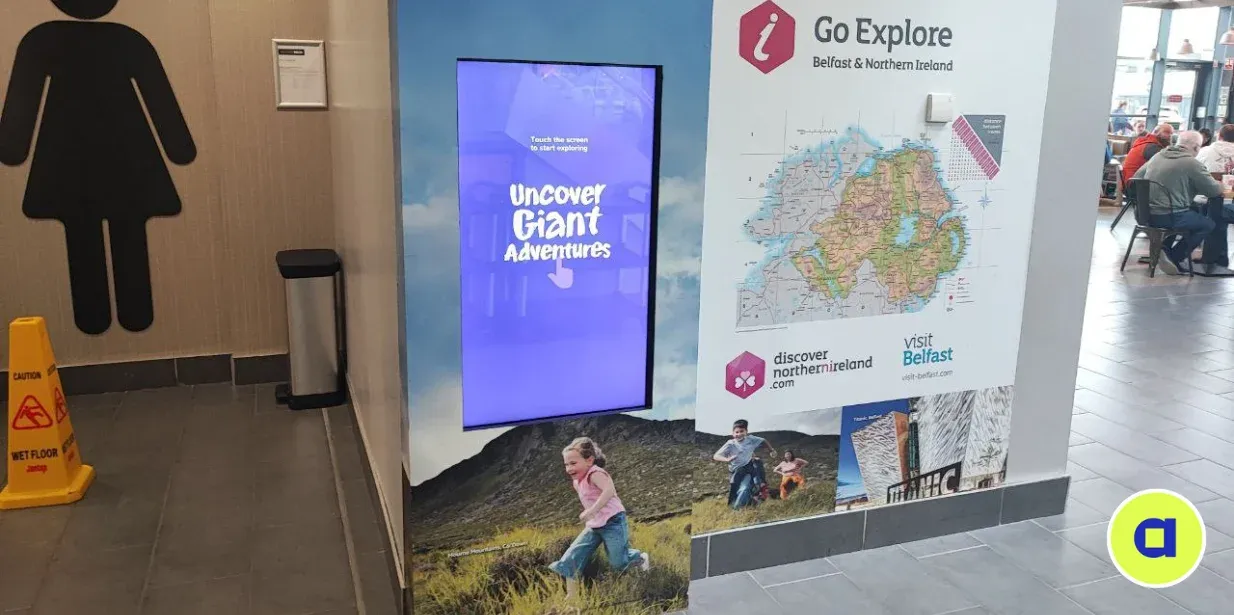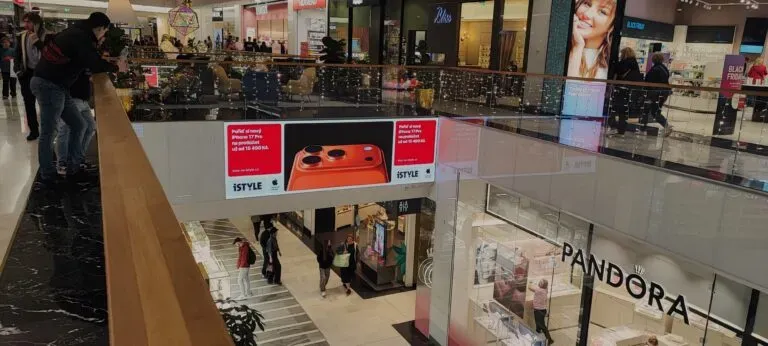Digital Signage in museums increases memorability by 60%
Museums are actively transforming to meet the modern expectations of visitors.
Digital Signage plays an important role in this process by presenting information in a modern format. Digital signage systems are not just displays or projectors, but a complete complex that includes interactive kiosks, LED screens, digital signage players, digital signage software, as well as indoor audio players. Thanks to these technologies, museums can create, edit, distribute, and manage various multimedia content.
The importance of modern digital solutions in museums
The use of Digital Signage in museum spaces significantly changes the approach to communication with visitors. Digital menus and informational screens not only inform but also help with orientation, improve exhibitions, and create interactive objects through which collections become more accessible and engaging. Digital signage software allows for quick updates of information and adaptation of content for different visitor groups.
Main advantages of using Digital Signage
The implementation of digital technologies in museums provides a number of advantages:
– Prompt information updates: Visitors always receive up-to-date data about exhibitions, events, schedules, or changes in expositions.
– Convenient navigation: Digital maps and navigation signs help easily locate the necessary halls or exhibits.
– Multilingual content: Digital Signage enables broadcasting information in several languages, making the museum accessible to foreign guests.
– Interactivity: Self-guided tours, educational programs, and interactive stands increase interest in the exhibitions.
– Efficient use of resources: Reduction of costs for printing posters and announcements thanks to digital solutions.
– Dynamic content: The ability to show artist biographies, interesting facts, curators’ thoughts, or video reviews.
A digital signage player and digital signage software help museums quickly respond to changes and ensure effective content management. A Harvard University study showed that the perception of information through gamification increases memorability by 60%.
Examples of digital signage use in museums
Museums use digital solutions in various areas of their operations:
– Information screens at the entrance and in the lobby help guests get oriented from the very first moments of their visit.
– Ticketing area: a digital menu and indoor audio player inform about tickets, promotions, and special offers.
– Navigation signs: interactive maps help avoid confusion in large exhibitions.
– Exhibition and event schedules: dynamic displays show current museum events.
– Electronic labels for exhibit descriptions: provide more information than traditional paper signs, with the option to include video or audio.
– Exhibition enhancement: video and audio content make exhibits more engaging.
– Interactive stands: allow self-guided tours using modern technology.
– Promotion of events and programs: digital signage helps effectively advertise upcoming events and special offers.
– Social activity screens: broadcast reviews, photos, or videos from social networks.
– Appreciation of artists and patrons: digital panels for gratitude and recognition.
– Subscription advertising: dynamic content encourages sales.
– Digital menu in museum cafés: a modern way to inform about the selection and prices.
Which screen is best suited for museums?
Choosing the optimal display for a museum space depends on many factors: room size, type of exhibition, the specifics of the content, and the intended purpose. Modern museums are increasingly implementing digital solutions that not only inform but also engage visitors in interactive experiences. It is also important to consider the capabilities offered by LED screen software, the digital signage system, and a modern CMS (content management system) for centralized content control.
LED screens
LED screens are ideally suited for creating large multimedia installations in spacious halls or on building facades. They are often used as media facades for shopping centers or for outdoor digital advertising, since they provide a bright and dynamic image that is clearly visible even under intense lighting. Such solutions allow museums to create large-scale video installations that attract attention and emphasize the uniqueness of the exhibition.
Among the advantages of LED screens are the ability to display large-format content, brightness and contrast, which makes them especially effective for attracting visitors. However, certain disadvantages should also be considered: significant weight of the structure, increased energy consumption, limited image detail per square meter, and a not very wide color gamut. For the effective operation of such screens, specialized software is required, which allows quickly changing digital advertising and managing multimedia projects.
Liquid crystal LCD displays
LCD displays are the most common choice for informing visitors, creating interactive kiosks, and digital menus. They are available in various sizes, have high resolution and vivid colors, which makes it possible to display both text and graphic information with a lot of detail. Touchscreen models open up opportunities for creating interactive installations and information stands.
The advantages of LCD displays include image clarity, a wide color gamut, and the ability to present complex digital exhibits. At the same time, there are certain limitations: possible glare in brightly lit rooms, screen size limitations, the need for constant power supply, and higher cost of large panels. For continuous operation and convenient content management, it is advisable to use a digital signage system with a built-in media player and centralized control via CMS.
E-ink displays
E-ink technology is ideal for creating electronic signs, posters, navigation signs, and other information carriers that do not require a constant power connection. Such screens have an appearance similar to a paper sign, do not glare, and blend harmoniously into the museum space. They are especially effective where silence, autonomy, and preservation of a calm atmosphere are important.
Among the advantages of e-ink displays are exceptional energy efficiency, the ability to remotely update information through a CMS, absence of glare, and ease of installation without laying cables. Such solutions allow museums to quickly change information, display it in different languages, and keep content up-to-date without additional printing costs. The main disadvantages are a limited color range, lack of video support, and the high cost of large screens.
The role of digital systems in integrating museum spaces
A modern digital signage system in a museum is not just a set of displays, but a complex infrastructure that unites various types of screens, software for LED displays, media facades for shopping malls, digital advertising, and a centralized CMS. Thanks to this integration, the museum can easily manage all information flows, adapt content for different audiences, quickly respond to changes in exhibitions, and improve the level of service for visitors.
The choice of a particular type of screen depends on the museum’s tasks, budget, spatial features, and the desired effect. Competent use of modern digital solutions makes it possible to create an innovative museum space that is attractive, functional, and convenient for all visitors.
Media players: the key to effective content playback
For high-quality video content playback on advertising screens, digital menu boards in cafés, or other digital displays, special equipment is required — a media player. This is a device that receives, stores, and plays media files according to a predefined schedule and sequence. It generates a video signal and sends it to the display, ensuring continuous and high-quality content presentation.
Variety of media players on the market
Today, there is a wide variety of media players, differing in specifications, functionality, and purpose. Most basic models simply allow videos to be played in sequence. These players are often built directly into professional displays, which simplifies installation but at the same time creates dependence on a specific brand. This means that, to ensure compatibility across the entire digital signage system in a museum or café, one has to purchase displays from the same manufacturer, which can limit flexibility and increase costs.
Advantages of Android set-top boxes in digital signage
Modern venues, including museums and cafés, seek greater autonomy and efficiency and are therefore increasingly choosing Android set-top boxes or Android media players. These devices run on an open platform, allowing various software to be installed, functionality to be tailored to specific needs, and integration with a centralized video management system.
Android set-top boxes are known for their ease of use, wide customization options, and support for multiple content formats. They are ideal for managing digital menu boards in cafés, where information about dishes and promotions needs to be updated quickly, as well as for advertising screens that require dynamic and engaging playback of promotional videos.
Intelligent digital signage solutions for automation
Innovative digital signage solutions include media players with automatic content generation features. For example, the Advision media player operates on a specialized operating system and can use artificial intelligence to combine text, graphic, audio, and video elements into dynamic video clips. This significantly simplifies the staff’s work, freeing up time for other important tasks.
Such devices are characterized by high performance, autonomy, scalability, and security. They are ideal for large museum complexes, shopping malls with media facades, as well as for food service venues with digital menus, where it is important to quickly update information and maintain display quality.
Centralized video management system: convenience and control
To efficiently manage a large number of screens and media players in museums, shopping centers, or cafés, a centralized video management system is used. It allows remote content control, creation of playback schedules, quick updates, and analysis of viewing statistics.
Thanks to integration with Android set-top boxes or other media players, the centralized management system provides flexibility and scalability for digital signage projects. This enables quick audience response, optimization of staff operations, and increased effectiveness of advertising campaigns and informational messages.
Conclusion
The choice of a media player is a key element of any digital signage system. The use of modern Android set-top boxes, integrated with a centralized video management system, makes it possible to create dynamic, attractive, and easily manageable content for advertising screens, digital menu boards in cafés, and other digital installations. Intelligent solutions such as Advision media players open new horizons for automation and optimization of operations, making venues more modern and customer-oriented.
Advision — Content Management System for remote management and media planning of video and audio content broadcast. We help offline businesses and advertising companies automate workflows and implement reliable Digital Signage infrastructure using our own software and hardware solutions.
Contact us and we will help you implement the most modern technologies to solve your problems!




















